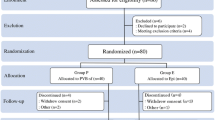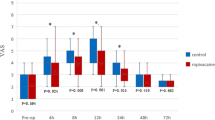Abstract
Purpose
We aimed to investigate the optimal dose of continuous epidural ropivacaine for effective analgesia with minimal side effects after axillary muscle-sparing thoracotomy.
Methods
Sixty patients undergoing thoracic surgery via the axillary approach were studied. Patients were given continuous epidural ropivacaine at 6 (group R-6), 9 (group R-9), 12 (group R-12) or 18 mg·h−1 (group R-18) in a randomized double-blinded fashion after surgery. All of the patients received nonsteroidal anti-inflammatory drugs (NSAIDs) every 6 h for 24 h postoperatively. Pain intensity was assessed under three conditions (at rest, on moving, and while coughing), at 4, 8, 16, 24, and 48 h after surgery, and the extent of sensory block was evaluated at the same time points. The ability of a patient to walk unaided was assessed at 24 and 48 h after surgery.
Results
Pain intensity at rest and coughing was significantly higher in group R-6 than in the other groups at 16 h after surgery. Pain intensity during moving was significantly greater in group R-6 than in groups R-12 and R-18 at 16 h after surgery. Group R-18 exhibited a significantly greater extent of sensory block than the other groups. The number of patients who were not able to walk unaided 24 h after surgery was significantly greater in group R-18. There were no significant differences in the incidences of side effects among the groups.
Conclusion
Our results showed that epidural analgesia using ropivacaine, at 12 mg·h−1, provided the best analgesia with few side effects.
Similar content being viewed by others
References
SR Hazelrigg RJ Landreneau TM Boley M Priesmeyer RA Schmaltz W Nawarawong JA Johnson JT Walls JJ Curtis (1991) ArticleTitleThe effect of muscle-sparing versus standard posterolateral thoracotomy on pulmonary function, muscle strength and postoperative pain J Thorac Cardiovasc Surg 101 394–400 Occurrence Handle1999932 Occurrence Handle1:STN:280:DyaK3M7lsFCjsg%3D%3D
A Macias P Monedero M Adame W Torre I Fidalgo F Hidalgo (2002) ArticleTitleA randomized, double-blinded comparison of thoracic epidural ropivacaine, ropivacaine/fentanyl, or bupivacaine/fentanyl for postthoracotomy analgesia Anesth Analg 95 1344–1350 Occurrence Handle12401624 Occurrence Handle10.1097/00000539-200211000-00046 Occurrence Handle1:CAS:528:DC%2BD38XptlChsrk%3D
G Tuncel G Ozalp S Savli O Canoler M Kaya N Kadiogullari (2005) ArticleTitleEpidural ropivacaine infusions for post-thoracotomy pain Eur J Cardiothorac Surg 28 375–379 Occurrence Handle16054823 Occurrence Handle10.1016/j.ejcts.2005.05.017
DA Scott D Blake M Buckland R Etches R Halliwell C Marsland G Merridew D Murphy M Paech SA Shug G Turner S Walker K Huizar U Gustafsson (1999) ArticleTitleA comparison of epidural ropivacaine infusion alone and in combination with 1, 2 and 4 µg/ml fentanyl for 72 hours of postoperative analgesia after major abdominal surgery Anesth Analg 88 857–864 Occurrence Handle10195538 Occurrence Handle10.1097/00000539-199904000-00033 Occurrence Handle1:CAS:528:DyaK1MXislKrurw%3D
G Brodner N Mertes HV van Aken T Mollhoff M Zahl S Wirtz (2000) ArticleTitleWhat concentration of sufentanil should be combined with ropivacaine 0.2% wt/vol for postoperative patient-controlled epidural analgesia Anesth Analg 90 649–657 Occurrence Handle10702452 Occurrence Handle10.1097/00000539-200003000-00027 Occurrence Handle1:CAS:528:DC%2BD3cXhvFWntbw%3D
CN Tan A Guha ND Scawn SH Pennefather GN Russel (2004) ArticleTitleOptimal concentration of epidural fentanyl in bupivacaine 0.1% after thoracotomy Br J Anaesth 92 670–674 Occurrence Handle15033892 Occurrence Handle10.1093/bja/aeh129 Occurrence Handle1:CAS:528:DC%2BD2cXjs1WrtLo%3D
F Benedetti S Vighetti C Ricco M Amanzio L Bergamasco C Casadio R Cianci R Giobbe A Oliaro B Bergamasco G Maggi (1998) ArticleTitleNeurophysiologic assessment of nerve impairment in posterolateral and muscle-sparing thoracotomy J Thorac Cardiovasc Surg 115 841–847 Occurrence Handle9576220 Occurrence Handle10.1016/S0022-5223(98)70365-4 Occurrence Handle1:STN:280:DyaK1c3jsFOmsQ%3D%3D
AM Geurts HJ Jessen JH Megens MA Hasenbos MJ Gielen (1995) ArticleTitleContinuous high thoracic epidural administration of morphine with bupivacaine after thoracotomy Reg Anesth 20 27–32 Occurrence Handle7727324 Occurrence Handle1:STN:280:DyaK2M3ksVektw%3D%3D
DG Snijdelaar MA Hasenbos J van Egmond AP Wolff TH Liem (1994) ArticleTitleHigh thoracic epidural sufentanil with bupivacaine: continuous infusion of high volume versus low volume Anesth Analg 78 490–494 Occurrence Handle8109766 Occurrence Handle10.1213/00000539-199403000-00013 Occurrence Handle1:STN:280:DyaK2c7lt1ynuw%3D%3D
A Gottschalk M Freitag MA Burmeister C Becker EP Horn T Standl (2002) ArticleTitlePatient-controlled thoracic epidural infusion with ropivacaine 0.375% provides comparable pain relief as bupivacaine 0.125% plus sufentanil after major abdominal gynecologic tumor surgery Reg Anesth Pain Med 27 367–373 Occurrence Handle12132060 Occurrence Handle10.1053/rapm.2002.32583 Occurrence Handle1:CAS:528:DC%2BD38XmsVGrsrs%3D
DA Scott DM Chamley PH Mooney RK Deam AH Mark B Hagglof (1995) ArticleTitleEpidural ropivacaine infusion for postoperative analgesia after major lower abdominal surgery—a dose finding study Anesth Analg 81 982–986 Occurrence Handle7486088 Occurrence Handle10.1097/00000539-199511000-00015 Occurrence Handle1:CAS:528:DyaK28Xit1ygtw%3D%3D
NH Badner D Reid P Sullivan S Ganapathy ET Crosby J McKenna A Lui (1996) ArticleTitleContinuous epidural infusion of ropivacaine for the prevention of postoperative pain after major orthopaedic surgery: a dose-finding study Can J Anesth 43 17–22 Occurrence Handle8665629 Occurrence Handle1:STN:280:DyaK283ktV2rtA%3D%3D Occurrence Handle10.1007/BF03015952
SA Schug DA Scott J Payne PH Mooney B Hagglof (1996) ArticleTitlePostoperative analgesia by continuous extradural infusion of ropivacaine after upper abdominal surgery Br J Anaesth 76 487–491 Occurrence Handle8652317 Occurrence Handle1:CAS:528:DyaK28XislOmtL4%3D
G Turner D Blake M Buckland D Chamley P Dawson C Goodchild J Mezzatesta D Scott A Sultana S Walker M Hendrata P Mooney M Armstrong (1996) ArticleTitleContinuous extradural infusion of ropivacaine for prevention of postoperative pain after major orthopaedic surgery Br J Anaesth 76 606–610 Occurrence Handle8688255 Occurrence Handle1:CAS:528:DyaK28XjsFWiurg%3D
RC Etches WD Writer D Ansley PA Nydahl BY Ong A Lui N Badner S Kawolski H Muir R Shukla WS Beattie (1997) ArticleTitleContinuous epidural ropivacaine 0.2% for analgesia after lower abdominal surgery Anesth Analg 84 784–790 Occurrence Handle9085958 Occurrence Handle10.1097/00000539-199704000-00016 Occurrence Handle1:CAS:528:DyaK2sXis1Gku7k%3D
NB Scott DW Forbes AR Binning (1994) ArticleTitleThe effect of parenteral diclofenac and morphine on duration and height of blockade of continuous epidural infusion of bupivacaine 0.5 Anaesthesia 49 594–596 Occurrence Handle8042724 Occurrence Handle1:STN:280:DyaK2czhslOmuw%3D%3D Occurrence Handle10.1111/j.1365-2044.1994.tb14227.x
BT Veering MJ Cousins (2000) ArticleTitleCardiovascular pulmonary effects of epidural anaesthesia Anaesth Intensive Care 28 620–635 Occurrence Handle11153287 Occurrence Handle1:STN:280:DC%2BD3M7ltlSisw%3D%3D
S Liu JM Angel BD Owens RL Carpenter L Isabel (1995) ArticleTitleEffects of epidural bupivacaine after thoractomy Reg Anesth 20 303–310 Occurrence Handle7577778
S Sakura M Sumi Y Yamada Y Saito Y Kosaka (1998) ArticleTitleQuantitative and selective assessment of sensory block during lumbar epidural anaesthesia with 1% or 2% lidocaine Br J Anaesth 81 718–722 Occurrence Handle10193282 Occurrence Handle1:CAS:528:DyaK1cXnvVCqsLk%3D
Author information
Authors and Affiliations
About this article
Cite this article
Sakai, T., Tomiyasu, S. & Sumikawa, K. Epidural ropivacaine infusion for the treatment of pain following axillary muscle-sparing thoracotomy: a dose-evaluation study. J Anesth 21, 320–324 (2007). https://doi.org/10.1007/s00540-007-0527-9
Received:
Accepted:
Published:
Issue Date:
DOI: https://doi.org/10.1007/s00540-007-0527-9




